1997 – Arnold Lindberg
He began his career at Disney working as a mechanic, and after a few years progressed to head of technical constructions. By the time Lindberg retired, after 40 years with Disney, he was the Technical Director of all workshops at Disney World, overseeing more than 400 employees. He is also a gifted singer and folk dancer and has made several recordings of Swedish songs.(Arnold and his lovely wife Eira were two of the founders of the Scandinavian Hagar Viking Club in Orlando. They and a few others started the club after moving from Los Angeles to Orlando to open up Walt Disney World)
 |
Fred Gurley Locomotive - Restoration under Arnold Lindberg's responsibility Disneyland Engine No. 3 - Fred Gurley
Unlike the more modern C.K. Holliday & the E.P. Ripley, the Fred Gurley was originally built in 1894 by the Baldwin Locomotive Works in Pennsylvania. The locomotive was purchased in Louisiana, where it was originally used to transport sugar cane. The working engine was purchased for Disney in 1957, at a cost of $1,500. It was restored and named in honor of Fred G. Gurley, then president & executive chairman of the Atchison, Topeka & Santa Fe Railway (1944-1957). After its extensive $35,000 restoration, the Fred Gurley's first trip around Disneyland was made on March 28, 1958.
|
......The little engine was moved into the Studio Machine Shop to begin her restoration. Arnold Lindberg, head of the shop, would handle the work. As with any restoration of this nature, the entire locomotive was completely disassembled and a thorough inspection of every single part was made. What could be used was saved, the rest scrapped.
In Walt Disney's Railroad Story, author Michael Broggie recounts how Lindberg was given his assignment:
"The renovation of the engine was just beginning and the remaining parts that weren't scrapped were all laying all over the shop's floor. So, one afternoon, when I was the swing shift boss, I had just come in and was standing in the middle of all these engine parts. Roger came up and handed to me a green book: BALDWIN LOCOMOTIVES. He asked me if I had ever built a locomotive. I said �No,' looking around at the pieces. Typical of Roger's style of communicating, he said, �Well, here's the book--do it.'
"Those were my marching orders. We didn't have thousands of work orders and everyone and his grandmother involved in approvals. Hell no, the studio wasn't run like that in the early days. We just did what we had to do to get the job done."
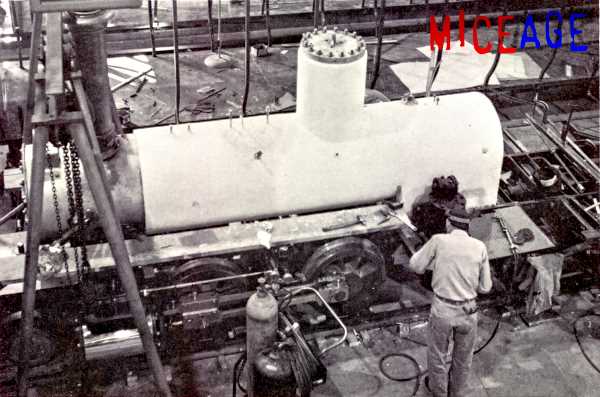
The boiler and steam dome appear white because they are coated in insulation.
Photo courtesy Michael Broggie.
So, Lindberg and his crew set to work rebuilding the engine. The rotted cab was scrapped, and a new one built of hardwood. The original open cab wasn't copied, and instead, an all-enclosed cab was built with arched windows all around. Dixon Boiler Works built a new, all-welded boiler for the engine, and a two-wheel "pony" truck was added right behind the new wooden pilot (also known as a cowcatcher).
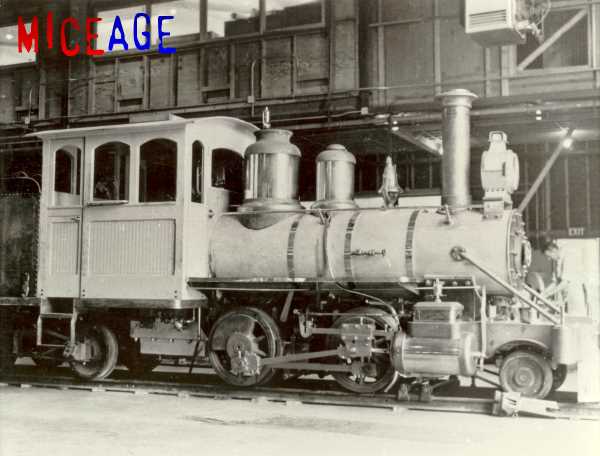
The almost-completed engine sits in the Studio machine Shop.
Sheet brass encased the cylinders and boiler-top domes, and a new headlight--based on an authentic design provided by Jerry Best--was created by Disney from sheet metal. A new tender tank was also fabricated, and a three-chime Lunkenheimer whistle supplanted the original Baldwin single-chime. Because the Disneyland trains relied on air brakes, a Westinghouse air compressor was installed inside the cab, on the fireman's side. This was done to preserve the pre-air-brake looks of the locomotive (both the Ward Kimball and theErnest S. Marsh have their compressors located inside the cab as well).
As we discovered in my article on the engine's builder's plates, Roger Broggie, using the originals as patterns, created reproductions. The engine still had a number of genuine Baldwin components, however, including her frame, wheels and drive rods, tender truck, domes, cylinders and valve gear, bell and jaunty cast iron cap stack.
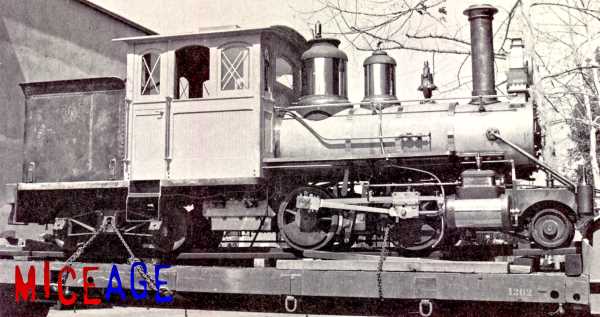
Here, the engine has been loaded onto a flatbed truck awaiting transport to
Disneyland. The masking tape "X's" on the windows help to show that there is
glass in the window frames--which might not be too apparent otherwise,
and which could lead to breakage through carelessness.
Final assembly was completed on February 9, 1958, and the engine was trucked down the Santa Ana Freeway to Disneyland, where the resurrected little steamer would be painted and finished.
The boiler was finished in a dark grayish-blue to represent the original planished iron, and at the engine's front end, the smoke box and smoke stack were painted with a mixture of boiled linseed oil and powdered graphite--a coating able to withstand the high heat on this un-insulated portion of the engine. The cab and tender were painted in a dark green, with red window sashes and trim. Highly polished brass rounded out the finish, covering the cylinders and dome centers, and wrapping around the boiler jacket and pilot edge.
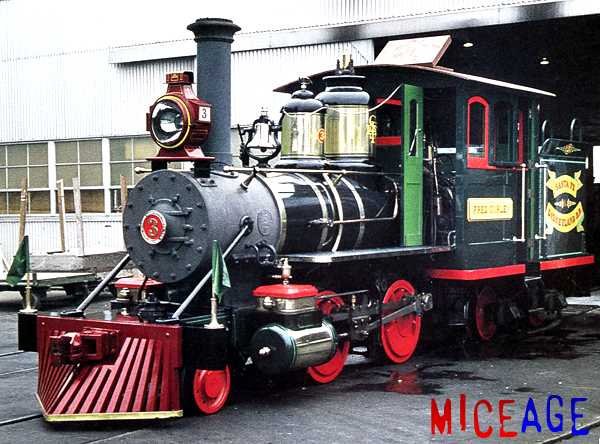
The newly refinished Fred Gurley, posing in front of the old roundhouse.
Photo courtesy Michael Broggie.
A reproduction Baldwin number plate, with a raised brass "3" cast into its center, completed the engine. On an overcast spring Thursday, March 27, 1958, with the yellow coaches of Retlaw 1 in tow, the engine began its break-in runs.
Like a prison inmate, the locomotive was only known by a number for most of her life, but now, a name proudly graced her cab sides: Fred Gurley. Gurley was the Chairman of the Board of the Santa Fe Railway in 1958, and he was a personal friend of Walt's. The name also continued the Disneyland tradition of naming its locomotives for Santa Fe executives.
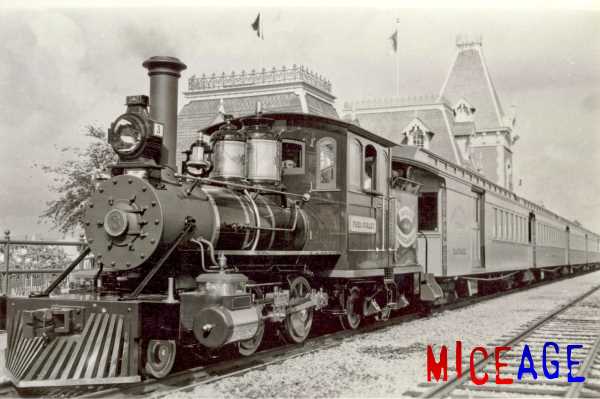
The engine was posed in front of Main Street Station during her break-in run
for a series of photos (above). Too bad her number plate was crooked! (below)
for a series of photos (above). Too bad her number plate was crooked! (below)
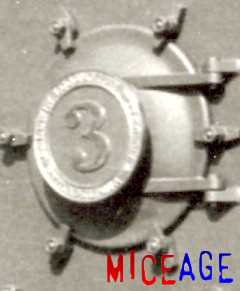
The little engine from the Louisiana cane fields, which had probably cost less than $3,000 in 1894, had cost Disney $37,061 to recondition. While a staggering amount for the time, the money was well spent. As Jerry Best noted, "This shows how a sow's ear can be turned into a silk purse if enough money, time, patience and skill is put into it."
The engine became operational for the public a day later, on March 28, 1958, and a few days after that, she was dedicated, along with another attraction that just happened to be opening at the same time--the Grand Canyon Diorama. The Santa Fe's in-house publication, The Santa Fe Magazine, covered the presentation, and states it occurred on "the first day of Easter Vacation." Assuming the writer meant the Monday before Easter Sunday, that would have been March 31, 1958.


LINDBERG, RICHARD
ARNOLD, Richard Arnold Lindberg was born to Eira and Arnold Lindberg on Feb. 15, 1958. Ricky as he was known to all was a wonderful and loving person. Even though he had Down Syndrome, he led a full and giving life. He not only thrived in the Special Olympics, earned the Order of the Arrow in Boy Scouts, he added to his community with a full time job. Ricky also had true belief in the Lord, as he read his Bible every day. He was a member of Delaney Street Baptist Church for many years and his friends will greatly miss him. Ricky brought great gladness to all he encountered with his easy laugh and great affection to all that he met. He never met a stranger and believed that every day was a blessing. Ricky was always included in the mainstream of life thanks to his mother and father and traveled throughout the United States and Sweden. Ricky's love of music was encouraged through his mother and father and we know he will be playing his accordion while his father sings along in heaven. Many family and friends will miss him but we know he is in a better place. A memorial service will be held at Delaney Street Baptist Church the week of Thanksgiving. In lieu of flowers donations may be made to the Delaney Street Baptist Church








